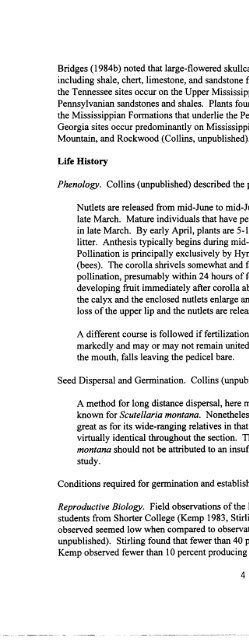Large-flowered Skullcap Recovery Plan - U.S. Fish and Wildlife ...
Large-flowered Skullcap Recovery Plan - U.S. Fish and Wildlife ...
Large-flowered Skullcap Recovery Plan - U.S. Fish and Wildlife ...
You also want an ePaper? Increase the reach of your titles
YUMPU automatically turns print PDFs into web optimized ePapers that Google loves.
Bridges (1984b) noted that large-<strong>flowered</strong> skullcap sites occur on a variety ofgeologic strata,<br />
including shale, chert, limestone, <strong>and</strong> s<strong>and</strong>stone from Cambrian to Pennsylvanian age. Most of<br />
the Tennessee sites occur on the Upper Mississippian Pennington Formation <strong>and</strong> Lower<br />
Pennsylvanian s<strong>and</strong>stones <strong>and</strong> shales. <strong>Plan</strong>ts found on Lookout Mountain occur on some of<br />
the Mississippian Formations that underlie the Pennington (McKerrow <strong>and</strong> Pyne 1993).<br />
Georgia sites occur predominantly on Mississippian Formations, including Rome, Red<br />
Mountain, <strong>and</strong> Rockwood (Collins, unpublished).<br />
Life History<br />
Phenology. Collins (unpublished) described the phenology ofthe species as follows:<br />
Nutlets are released from mid-June to mid-July, overwinter, <strong>and</strong> apparently germinate in<br />
late March. Mature individuals that have perenneated as root stocks begin shoot growth<br />
in late March. By early April, plants are 5-10 cm tall <strong>and</strong> are pushing through the leaf<br />
litter. Anthesis typically begins during mid-May <strong>and</strong> continues through early June.<br />
Pollination is principally exclusively by Hymenoptera of the superfamily Apoideae<br />
(bees). The corolla shrivels somewhat <strong>and</strong> falls from the calyx one or two days after<br />
pollination, presumably within 24 hours of fertilization. The calyx closes around the<br />
developing fruit immediately after corolla abscission. During the next two to four weeks,<br />
the calyx <strong>and</strong> the enclosed nutlets enlarge <strong>and</strong> mature. The calyx then dehisces by the<br />
loss ofthe upper lip <strong>and</strong> the nutlets are released.<br />
A different course is followed if fertilization does not occur. The corolla shrivels<br />
markedly <strong>and</strong> may or may not remain united to the calyx. The entire calyx, still open at<br />
the mouth, falls leaving the pedicel bare.<br />
Seed Dispersal <strong>and</strong> Germination. Collins (unpublished) states the following:<br />
A method for long distance dispersal, here meaning any distance over two miles, is not<br />
known for Scutellaria montana. Nonetheless, its opportunity for such dispersal seems as<br />
great as for its wide-ranging relatives in that nutlet morphology <strong>and</strong> calyx dehiscence are<br />
virtually identical throughout the section. Thus, the limited distribution ofScutellaria<br />
montana should not be attributed to an insufficient means ofdispersal without further<br />
study.<br />
Conditions required for germination <strong>and</strong> establishment have not been studied to date.<br />
Reproductive Biology. Field observations of the Marshall Forest population were made by two<br />
students from Shorter College (Kemp 1983, Stirling 1983). The reproductive potential they<br />
observed seemed low when compared to observations on related species (Collins,<br />
unpublished). Stirling found that fewer than 40 percent of the flowers formed fruit, while<br />
Kemp observed fewer than 10 percent producing fruit. Some of the difference in fruiting rate<br />
4

















